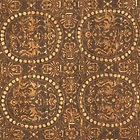The Gallery of Horyuji Treasures Room 6
July 10, 2012 (Tue) - August 5, 2012 (Sun)
The Horyuji Treasures were donated to the Japanese Imperial Family in 1878 by Horyuji temple in Nara. After World War II, they became the property of the Japanese nation. At the end of the catalogue created at the time of the original donation, there is an entry for 13 chests of scrap textile fragments. These textiles were arranged in different ways, including storage between layers of glass, or mounting onto traditional Japanese torinoko paper. In particular, the impressive works were preserved between glass and registered as textile pieces. The majority of the other pieces were left unregistered.
Even the pieces between glass are in poor condition: over the years, the insides of the glass have clouded up, and this cloudiness has spread close to the textiles. Owing to this, restoration of the textiles has been carried out since 2010. This exhibition coincides with a point when nearly half the restoration work has been completed. Among the dyed textiles, there is a rare example of cloth with attractive designs of flowering plants in gold and silver paint on a kokechi tie-dyed ground. In the examples of woven textiles, there is multi-weave plain nishiki brocade with a paired phoenix design, which is ancient even among brocades in which different warp threads are combined with single color weft threads. In this category there is also brocade with a design of small flowers that features a diagonal crosses pattern created by the meyui motif of kokechi tie-dyeing, as well as futsu (double weave cloth from China) with a small checkered pattern. Examples of twill include textiles with a scrolling grapevine arabesque design or a design of paired dragons and double bead roundels. These twill pieces are only small fragments, but their designs are rich in variety. This exhibition displays the diverse world of ancient textiles.

